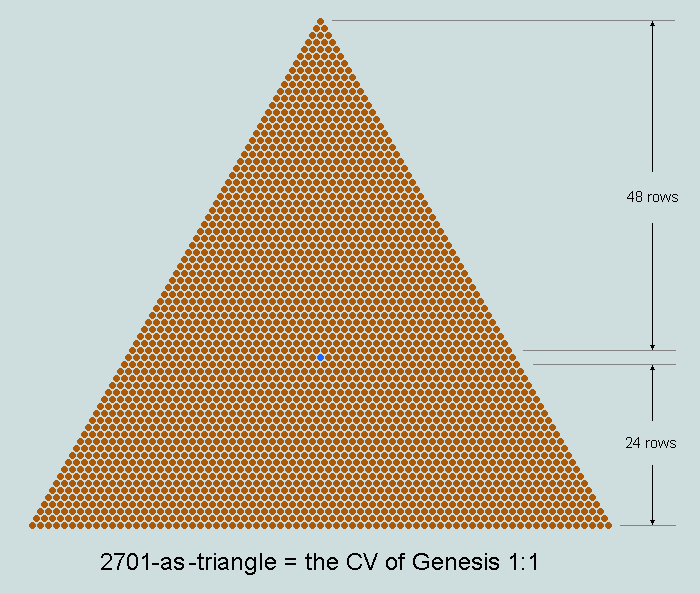
ASPECTS_FN: further primary geometries and other features of interest
Our purpose here is to add further detail which will serve to bring the facts introduced in the main page into stronger relief.
1. Concerning the position of the central counter of 2701-as-triangle

Here, the centroid counter (coloured blue) is seen to occupy the 25th position in a row of 49 counters - this being the 49th (as counted top-down), or the 25th (as counted bottom-up). These ordinals represent the squares of 5 and 7, respectively. Observe that the number of rows above and below the centroid are multiples of 12 - one the double of the other.
2. Concerning the number of counters forming the outline of 2701-as-triangle
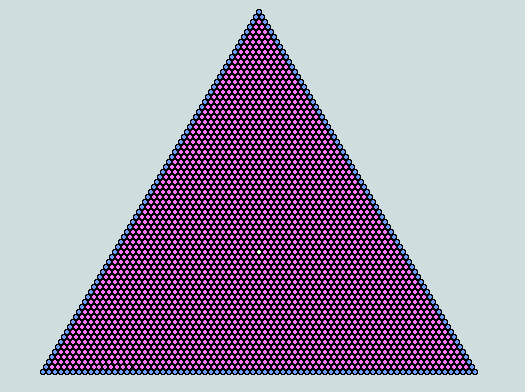
These counters (rendered blue) total 216 - the cube of 6 (first perfect number [1]), or 6.6.6. It is helpful here to change the form of these outline counters to unit cubes, and depict the phenomenon thus:
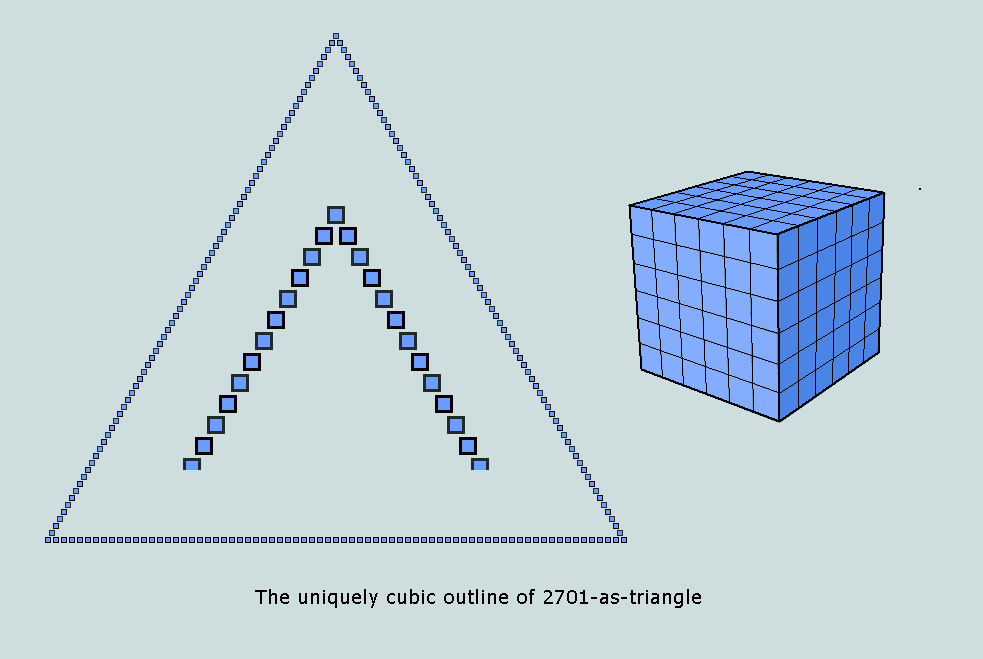
This happens to be the only cube whose total superficial area (as measured in unit squares) is numerically equal to its volume (in unit cubes). In this respect it is therefore unique!
3. Concerning the factors of 2701 - sum of the CVs of Genesis 1:1
2701 is the product of two mutually-reflective prime numbers which involve the biblically-potent digits 3 and 7, thus: 2701 = 37.73; observe that this is only true when the numbers are expressed in the usual denary notation; in other words, their visual relationship is mediated by 10 - the system radix. However, they are further related - now, absolutely - by their geometries, as depicted below:
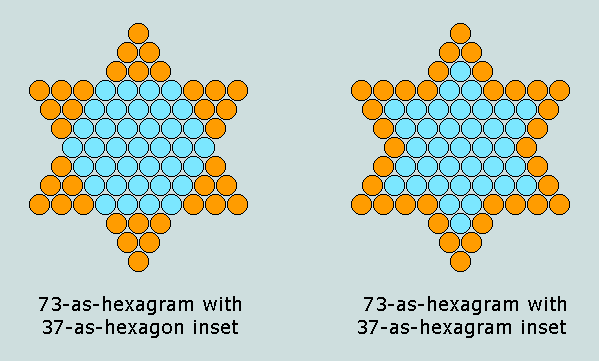
In that each of these figures embodies the factors of 2701-as-triangle, they may be regarded as alternative symbols for the Bible's first verse. But also observe here the 6-fold symmetries displayed and the dual role played by 37.
Remarkably, this same number has yet another regular form - as the following panel reveals:
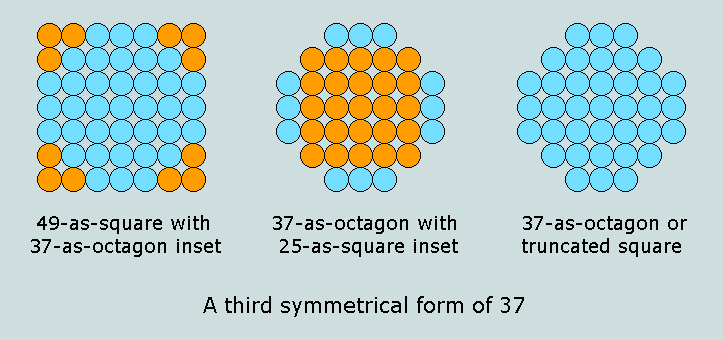
Clearly, the symmetrical removal of 12 counters from 49, or the addition of 12 counters to 25, generates 37 as octagon, and it follows that 37 is the arithmetic mean of the two squares involved in positioning the centroid counter in 2701-as-triangle.
Observe also that 37 = 64-27. In other words, it is the difference between the cubes of 4 and 3 - i.e. 37 = 4^3-3^3. This feature takes us further along the way of understanding - for all numbers which exhibit hexagonal symmetry represent the difference of consecutive cubes. In respect of 37, the matter is expressed pictorially as follows:
Clearly, this 3-D representation of 37 - what we have termed a 'solid gnomon' - is but another form of 37-as-hexagon. But now observe the interesting ambiguity revealed in the following diagram:
As viewed in a particular way, 37-as-gnomon may be mistaken for 64-as-cube! This becomes a significant feature in the outworking of the miracle.
4. Concerning the factors of 3003 - sum of the CVs of Genesis 1:1+
Whereas 2701 is the product of just two prime numbers, 3003 is the product of four, thus: 3003 = 3.7.11.13. Of particular interest is the composite factor 91. Like 37 this may be represented geometrically in three distinct ways by means of symmetrical aggregates of uniform counters - circular or spherical, as appropriate.
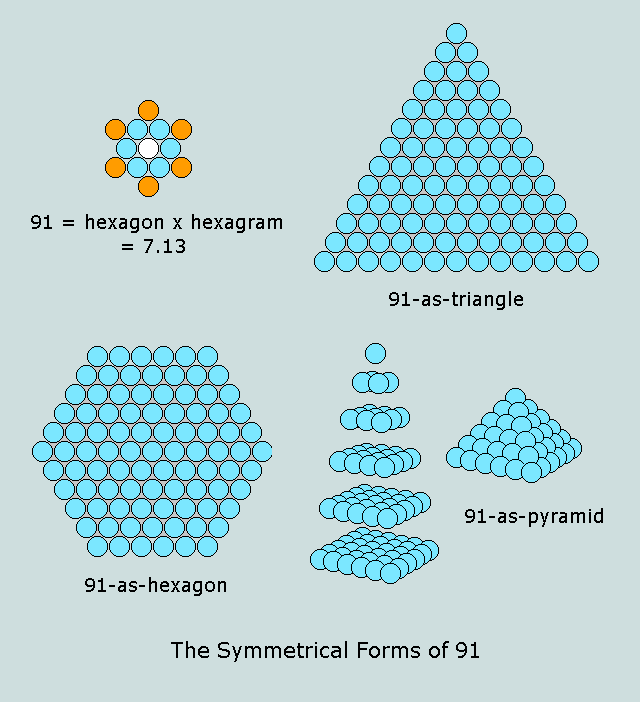
But in addition, observe that,
like 2701, 91 is the product of hexagon and related hexagram
91 = 64+27, i.e. 91 = 4^3+3^3 (in other words, it is the sum of the cubes whose difference = 37!)
because 91 is a hexagon, it is also the difference of two cubes and therefore a solid gnomon, thus:
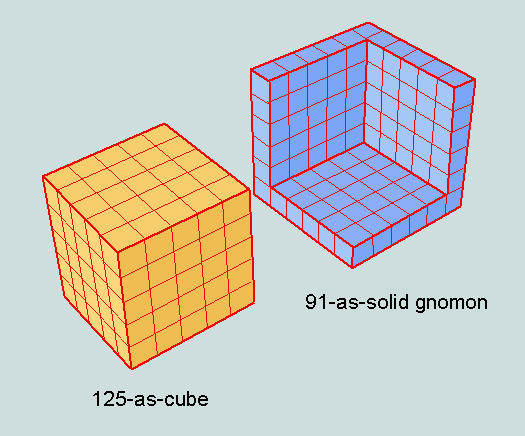
Observe that no other number possesses (or, betters) the symmetries of 37 and 91. In the world of number they are unique - yet both are to be found as factors of Genesis 1:1 and Genesis 1:1+!
5. Concerning the letters of Genesis 1:1
The Hebrew letters of Genesis 1:1 number 28; its words, 7. Remarkably, 28 is 7th triangular number, thus:
The verse begins with the letter at the apex of each triangle and proceeds as directed by the connecting lines. Observe here the two further triangles (the 6th and 3rd) that do not infringe word boundaries.
Note that the 7th, 37th and 73rd triangles (i.e. 28, 703 and 2701 - all involved in the Bible's first verse) are of a special kind: they are G-triangles; this means that each is capable of generating a hexagon/hexagram pair by self-intersection/self-union; it becomes possible because each is built around a single centroid counter; the procedure is now explained as it relates to 28-as-triangle.
At (a) we have a representation of the 7th triangular number - its centroid counter rendered white; an exploded view of the same (b) reveals it to comprise 9 smaller 'elemental' triangles set around the single centroid counter; the hexagon depicted at (c) is formed from 6 of these triangles, similarly centred, and the hexagram at (d), 12 of the same, in addition to the centroid counter. Observe that hexagon and hexagram are related geometrically (in the same manner as the factors of Genesis 1:1, 37 and 73, dscussed earlier) - a feature made clear by the use of a second colour at (d). These symmetrical figures, 19 and 37, which derive from the number of letters in the Hebrew form of the Bible's first verse are also the factors of 703 - triangular sum of CVs 6 and 7 and therefore associated with the words "and the earth." Thus, we find 19 x 37 = 703 = 37th triangular number.
6. Concerning the word CVs of Genesis 1:1+
There are two significant features to be noted here:
5.1 - When divided by 3, each word CV except the first delivers the remainder 2; the first, the remainder 1.
5.2 - All 8 word CVs are observed to be relatively close to a multiple of 100 - as the following diagram makes clear (i, the integer multiplier ranging from 1 to 9):
As may be seen, the CVs all lie within the green band - representing a mere 27% of the available range. On the basis of this feature the probability of Genesis 1:1+ being a random set is thus of the order of 10,000 to 1 against!
7. Concerning the abundance of multiples of 37 in Genesis 1:1
The CV of the Bible's first verse is 2701, or 37 x 73; words 6 and 7 are each multiples of 37 (407 = 11.37; 296 = 8.37); it follows that 37 - already shown to be highly significant as a number per se - must be regarded as a major player in these proceedings. This is readily confirmed - as the following analysis reveals.
Because 2701 (sum of the CVs of Genesis 1:1) is the product of the two primes 37 and 73 it may be alternatively represented by a rectangle having these dimensions, thus:
It will be observed that the outline of this figure comprises 216, or 6.6.6 units - thus matching that of its triangular representation.
We further observe that within this structure words 6 and 7 may be represented as rectangles of the same height (both being multiples of 37). Remarkably, the differences between each of the remaining words and nearest multiples of 37 form a coordinated set of multiples of 6.
The catalogue of composite rectangular panels contained within Genesis 1:1-as-rectangle is presented below. It reveals that the first five words interlock so as to give rise to two mutually-exclusive pairs of composite units - referred to as (A,B) and (A',B'), respectively; the rectangles associated with words 6 and 7 being designated C and D.
Regarding the first verse, these basic units and their various combinations give rise to a total of 23 rectangles - each representing a multiple of 37. Details of these structures are provided in the following table - their compositions given first in terms of the elementary rectangles - A, B, A', B', C, D - and again, as sums of the word CVs.
On the average, in any randomly-selected set of integers, 1 in every 37 will be a multiple of 37. Applying this principle to the 127 values represented by the 7 words of Genesis 1:1 and their various combinations, it is to be expected that 3 or 4 will have 37 as a factor. As has been shown here, there are actually 23 - ie over 6 times the expected number! This result becomes a dramatic feature of the accompanying factor profile for the verse where, for each of the values over the range 2 to 50, the frequency of its occurrence as factor in the set of 127 values determines the height of the corresponding column. The ideal profile - delineated by the smaller white squares - provides a backcloth against which the significance of the event may be assessed. In addition, when we consider again the singular attributes of 37 per se, it is indeed difficult to argue that this particular set is random!
>
8. Concerning numerical trapezia
In conventional mensuration the area of trapezium (i) is obtained as the product of the average of the parallel sides (a and b) by the height (h), thus:
Area (z) = h.(a + b)/2

Similarly, in numerical geometry, the number of uniform circular counters required to construct figure (ii) - typically the difference between the (m-1)th and nth triangular numbers - is given by
Number (Tz) = r.(m + n)/2
where r = number of rows and m and n are the numbers of counters forming top and base, respectively.
Observe that in the latter case, the value of n is determined by r and m (thus, n = m + r - 1), so that we may write
Tz = r.(2m + r - 1)/2, and designate the trapezium Tz(r,m).
Further observe that if Tz(r,m) is odd, then r is odd and (2m + r - 1) is even; and vice versa. It follows, therefore, that either r and (2m + r - 1)/2, or r/2 and (2m + r - 1) are factors of Tz. If Tz is rich in factors it may be depicted as a trapezium in many ways, and it is instructive to consider how r, m and n may then be evaluated in each case.
Example 1: Consider Tz = 3627 = 3 x 3 x 13 x 31 (the number associated with the CV of John 1:1).
The number is odd, thus r (the number of rows of trapezium counters) must be one of these factors (or a combination thereof); potentially, therefore, r = 3, 9, 13, 31, 39, 93, 117,...
For each r there is a corresponding (2m + r - 1)/2, or m + (r - 1)/2, [= Tz/r = 1209, 403, 279, 117, 93, 39...] and a corresponding (r - 1)/2, [= 1, 4, 6, 15, 19, 46, 58,...], so that m [= Tz/r - (r - 1)/2 = 1208, 399, 273, 102, 74, -7,...].
The possible geometrical solutions are therefore just 5 in number: Tz(3,1208), Tz(9,399), Tz(13,273), Tz(31,102) and Tz(39, 74). Observe that it is the last of these that provides a perfect plinth for the Genesis 1:1 triangle.
Example 2: Consider Tz = 302 = 2 x 151 (the difference between the 73rd and 77th triangles).
The number is even, thus r is even and r/2 is a factor of Tz; thus, r = 4 (i.e. Tz has 4 rows - no other solution possible); 2m + r - 1 = 151 (the other factor); 2m = 148; m = 74.
Hence, Tz(4,74) - a trapezium of 4 rows of 74, 75, 76 and 77, respectively.
9. Concerning certain common artefacts
The salient numerical features of Genesis 1:1 and related matters can be found among the characteristics of
10. Concerning the term 'figurate' as applied to numbers
Observe that the term 'figurate' is here restricted to those symmetrical 2-D or 3-D structures of a simple kind consisting of closely packed uniform counters (circles or spheres, squares or cubes, as appropriate); 2-D examples include equilateral triangles and the derivatives of certain of these - namely, hexagons, hexagrams, trapezia and rhombi; 3-D examples include tetrahedra, pyramids and cubes.
The study and application of these entities is here termed 'Numerical Geometry'.
11. Concerning the term 'perfect' as applied to numbers
In mathematics, a perfect number is defined as a positive integer which is the sum of its proper positive divisors, that is, the sum of the positive divisors excluding the number itself. Equivalently, a perfect number is a number that is half the sum of all of its positive divisors (including itself).
The first perfect number is 6, because 1, 2, and 3 are its proper positive divisors, and 1 + 2 + 3 = 6. Equivalently, the number 6 is equal to half the sum of all its positive divisors: ( 1 + 2 + 3 + 6 ) / 2 = 6.
The next perfect number is 28 = 1 + 2 + 4 + 7 + 14. This is followed by the perfect numbers 496, 8128, 33550336, 8589869056,...
Observe that, (i) there are just 6 examples in the first billion natural numbers and, (ii) all are even numbers. There are no known examples of odd perfect numbers.
#3 above reveals the factors of 2701 (i.e. 37 and 73) to be related figurate numbers. Significantly, the factors of 703 (i.e. 19 and 37) fall in with the same scheme - as the following geometrical symmetries confirm:
As we shall find, these features provide a basis for a number of compound representations of Genesis 1:1 and its 'earthly' component.
Interestingly, 19 is also the digit reflection of 91 which, as detailed in #4 above, is a factor of Genesis 1:1+ and vies with 37 in being the most symmetrical of numbers.
13. Concerning the Creation Triangles
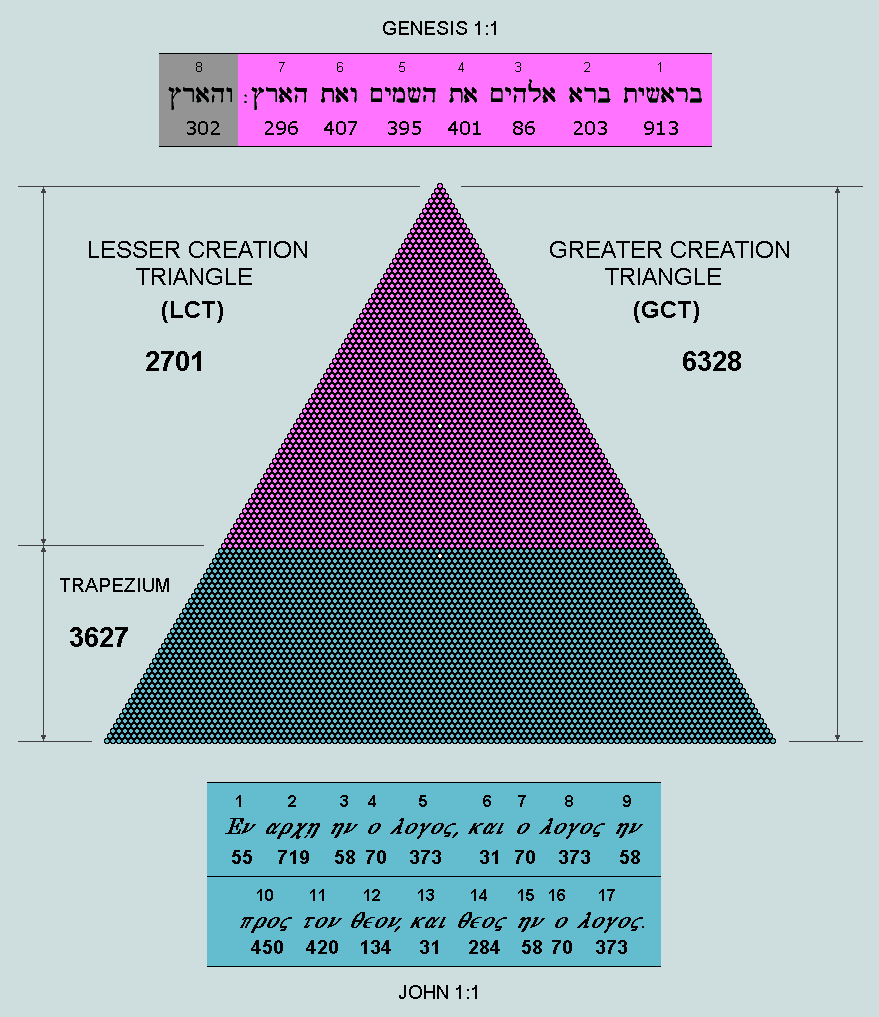
Like LCT, GCT is a 'generator' triangle and, as such, may be expressed as a triangular pattern of 9 smaller 'elemental' triangles disposed about a central counter, thus:
Remarkably, it transpires that these elementals are copies of the 37th triangular number, 703 - sum of words 6 and 7 of Genesis 1.1, translated '...and the earth.' - which has been shown to occupy a central position within LCT where it is gripped by a trio of 666-as-triangle, thus:
The number 666, of course, crops up in the biblical text of Revelation 13:18 where it is associated with the offer of wisdom in a time of gross apostasy. Clearly, there are strong predictive and symbolic elements in this diagram. To emphasise these matters further, consider the two following GCT depictions of the Creation:
Observe here the symmetrical nesting of G-triangles and the following detail:
the blue triangular annulus = 3627 = John 1:1
the purple triangular annulus = 1998 = 3 x 666
the green triangular core = 703 = "...and the earth."
It may be remembered that 2701-as-triangle has an outline of 216 - the unique cube of 6. Now augmented by the 3627-as-trapezium, this outline has become 333, or 9x37.
The diagrams are highly symbolic: the equilateral triangles suggesting God's triune nature; the plinth, a symbol of Christ in his role as Creator, and as Sustainer of his creation (Col.1:16, 17);
14. Concerning the solid gnomon as a structural element in hollow numerical cubes
A solid gnomon is the regular 3-D shape formed as the difference of a pair of consecutive cubes. It has already been observed that 37 is the difference between the cubes of 4 and 3
- The characteristic value of the 7th and last word of Genesis 1:1 - translated the earth - is 296, or 8. 37. In addition, it has been shown to be a factor of both components of The Name. Significantly, therefore, the 4th solid gnomon may be combined with a further seven to form a hollow cube of 296 units. This construction is depicted in the following diagrams - those on the left illustrating the early stages of this process.
The cube which fits perfectly inside this structure is, of course, 6.6.6, or 216 - the triangular outline of Genesis 1:1! There is the strong suggestion of profound symbolism here, for from within this first verse comes that which ultimately embraces it! And we are led to understand how special man is in the eyes of his Creator. Again, the symbolism built into the numbers themselves should not be overlooked: 8.8.8 (the cube of 8) suggesting 888 ('Jesus' - the Christ); 6.6.6 suggesting 666 (the Beast, or Antichrist); and their difference, 296 ('the earth' - centre of the battle that rages for the souls of men!). A further matter of interest concerns the outer- and inner- dimensions of these cubes: written side by side to form a denary object, these numbers spell '86' - the characteristic value of God as we find it in the Bible's third word!
Finally, it should be noted that three of the hollow cubes described above (representing 'Jesus') may be combined with a further five (representing 'Christ') to form a larger cube (representing The Name).
15. Concerning the visual relationship between hexagon and cube
We recognise the cube as the simplest and most familiar example of a regular solid; it has 6 square faces and its 3 spatial dimensions equal. In a typical 2-dimensional representation it appears as a segmented hexagon.
The cubes of 3, 4, 5 and 6 are depicted below as stacks of unit cubes - the numbers involved being 27, 64, 125 and 216, respectively. By inspection we learn that of these, one or more faces of only 19, 37, 61 and 91, respectively, are visible to the eye. In each case these are observed to reside within within the bounding hexagon and may be represented in idealised form as a close formation of of uniform circular counters - as shown below each cube.
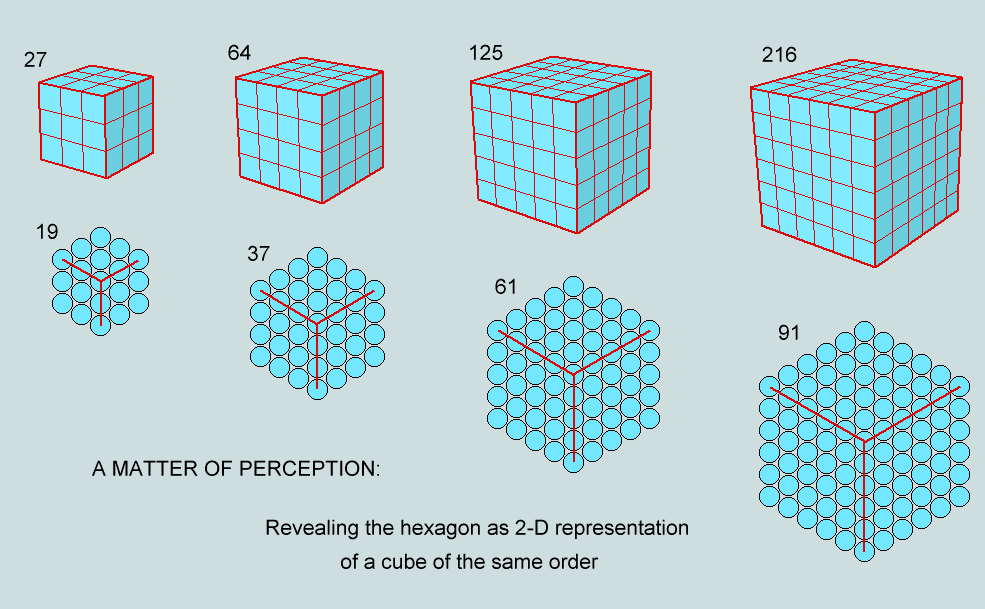
Clearly, the dimensions of cube and corresponding hexagon are identical. Observe that this line up includes 37 and 91, and also 19 the digit-reverse of the latter (a radix-dependent observation.) - all significant features of Genesis 1:1+.
In an earlier page 37 was depicted as a bifigurate numero-geometrical object. However, it is actually trifigurate - as the following figures prove. In other words, 37 counters laid out on a flat surface may be arranged in 3 distinct ways to form a symmetrical pattern, thus:
In this respect 37 is unique among the numbers.
Of particular interest to this account is the second of the 3 forms, the hexagon, in that this may be perceived as a representation of a 4x4x4 cube comprising 64 counters.
At (a) we have the normal hexagonal arrangement of 37 counters, and at (b) a typical representation of a cube - its outline taking the form of a hexagon. The salient features of this cube are shown superimposed on the hexagon at (c). Finally, at (d) we show a symbolic representation of the visual transformation hexagon ---> cube. We shall have occasion to use this symbol in the following section.
16. Concerning the appearance of 666 in other positional number systems
It is both interesting and instructive to consider what the number 'six hundred and sixty-six' might look like in systems where ten is not the dominant radix.
In recreational mathematics a repdigit is a natural number composed of repeated instances of the same digit, most often in the decimal numeral system. If the repeated digit is '1', the assembly is referred to as a 'repunit'.
Examples are 11, 666, 4444, 77777, and 999999. All repdigits are palindromic numbers and are multiples of repunits. One of the most famous repdigits is 666, referred to in Christian Eschatology as the number of the beast.
Clearly, when the number of digits in the repdigit is three there is a close visual correspondence with the cube of that digit - particularly when 'multiplied by' is represented by a stop ('.') - as in 6.6.6 (= 216) and 8.8.8 (= 512).
18. Concerning 'narcissistic' numbers
According to Greek mythology, Narcissus fell in love with his own reflection seen in a pool of water, and changed into the flower now called by his name.
Here, we introduce a particular class of numbers "in love with themselves" - viz, the Armstrong numbers; these defined as the sum of their own digits to the power of the number of digits. Such features are, of course, radix dependent. We consider only those which appear as natural phenomena in a 'base 10' context, and focus attention on the set of four 3-digit numbers which we shall refer to, collectively, as A, where A = {153, 370, 371,407}
[Commenting on this set in "A Mathematician's Apology", G. H. Hardy wrote: "There are just four numbers, after unity, which are the sums of the cubes of their digits. These are odd facts, very suitable for puzzle columns and likely to amuse amateurs, but there is nothing in them which appeals to the mathematician." This author, aware of their close association with Genesis 1:1+, begs to differ!]
We conclude this introduction to the A-set by noting some of its significant attributes:
A(2) + A(3) = 370 + 371 = 741 = 38th triangular number
A(1) + A(2) + A(3) = 894
A(1) + A(2) + A(3) + A(4) = 1301
A(2) and A(4) are multiples of the trifigurate number, 37
A(4) = 407 = 6th member of the G-set
One of the first FORTRAN programming exercises encountered by the writer required the student to determine all 3-digit numbers that were each the sum of the cubes of their individual digits. These were designated "The Sticklers" by the author of the book in which the problem appeared. It turns out that there are just four numbers that meet this specification, viz {153, 370, 371, 407}. The 2nd and 4th are multiples of 37 - their sum, 777; the former is a cyclic permutation of 703 (sum of words 6 and 7 of the Bible's first verse) and of 37, while the latter is the actual value of word 6! But observe also that the 1st and 3rd occur as surface features of the Judaeo-Christian Scriptures: 153 (17th triangular number) - the number of fishes caught in a net (John 21:11), and 371 - the duration of the Flood in days (Genesis 7-8)! But of particular interest in the current context is the fact that the sum of the first three is 894, while all four total 1301! As we have seen, these precise numbers appear in connection with even divisions within the first eight words of the Bible. All things considered, therefore, there clearly exists a surprisingly high degree of integration between what otherwise must be considered to be independent sets.
19. Concerning 'friendly' numbers
Two numbers are said to be friendly or amicable if each is equal to the sum of the proper divisors of the other. The classic example is the pair (220 / 284), which was known to the Pythagoreans. Here are the details:
- 220 = 1 + 2 + 4 + 71 + 142 (the proper divisors of 284) and
- 284 = 1 + 2 + 4 + 5 + 10 + 11 + 20 + 22 + 44 + 55 + 110 (the proper divisors of 220)
Such numerical curiosities are independent of system radix. They are not common, and before the advent of the computer were hard to find. Indeed, it was not until 1636 that a second pair (17296 / 18416) came to light. However, by the end of the 19th century the number of known pairs had been extended to 60. But then a remarkable event occurred: a lad of 16 discovered the pair (1184 / 1210). Now these are relatively small numbers, and considering the extensive searches for such pairs from Greek times onwards it is very hard to understand why this particular instance of the phenomenon should have been overlooked. However, here are the details:
- 1184 = 1 + 2 + 5 + 10 + 11 + 22 + 55 + 110 + 121 + 242 + 605 (the proper divisors of 1210) and
- 1210 = 1 + 2 + 4 + 8 + 16 + 32 + 37 + 74 + 148 + 296 + 592 (the proper divisors of 1184)
These numbers factorise as follows:
- 1184 = 2^5 x 37 = 4 x 296
- 1210 = 2 x 5 x 11^2 = 10 x 121
20. Concerning a geometric view of the Testaments
The Bible comprises 66 Books - 39 in the Old Testament and 27 in the New. Observe, (a) that the total is a triangular number, (b) 13, factor of 39, is a star (or hexagram) number, and (c) 9, factor of 27, is a square (or rhombus) number. Both 13 and 9 are associated with 3, another triangular number. The following figures depict these features of numerical geometry.
The three composites show the OT Books in white and NT Books in blue. Each possesses three axes of symmetry.
Clearly, the structure of the Bible - as we Protestant Christians know it - displays beautiful geometrical patterns!
The 17 Greek words comprising John 1:1 total 3627, or 39x93
Since 39 = (66 - 27), and 93 = (66 + 27), it follows that 3627 = 66^2 - 27^2
This is represented by the area EBCDGF(coloured purple)
The sides of this figure are 66, 39 and 27
and thus register the total number of books in the Bible, and in each of the Testaments
21. Concerning the use of the name 'Jesus'(
) and of the title 'Christ'(
) in the pre-Christian era
Most of the relevant material is to be found in the Septuagint - a Greek translation of the Old Testament dating from the 3rd century BC.
Occurrences of
in the Septuagint
- Nominative form (
): Exodus 17:13, 24:13; Numbers 14:6,38; title of book of Joshua =
= Jesus (son) of Naue; frequent references throughout 'Joshua', eg Joshua 1:10 et passim.
- Accusative form (
): Numbers 13:17; Haggai 1:1, etc.
- Genitive form (
): 1Kings ( = 3Kings in Septuagint) 16:34; Zechariah 6:11.
In the Apocrypha, the Prologue to Ecclesiasticus attributes the sayings in the work (dated c.132 BC) to Jesus ben Sirach - the name
appearing in Ecclesiasticus 50:27.
Occurrences of
in the Septuagint
- Nominative form (
): 1Samuel ( = 1Kings) 12:5, 16:6, 24:7; Lamentations 4:20.
- Accusative form (
): 2Samuel ( = 2Kings) 23:1.
- Genitive form (
): 1Samuel 2:10; Psalm 2:2.
- Dative form (
): 2Samuel 22:51; Isaiah 45:1.
This is not an exhaustive list, but enough to show that the title 'Christ' and the name 'Jesus' were widely known and used among the Greek-speaking Jews in the pre-Christian era. Identical forms of both are found in the Gospels and Epistles of the New Testament.
The author is indebted to Mr. Alan Hill (Senior Lecturer at the University of Glamorgan) for compiling this information.
In developing the sequence 1369 > 1368 > 912 > 913 we have observed that taking a third of 1368 we obtain 456. The progress of the digits of this number (as a denary, or base 10, object) suggest that we investigate all numbers of the form 100a + 10(a+1) + (a+2), where a is some positive integer.
Clearly, if N represents such a number, then N = 111a + 12. It follows that 3N + 1 is a multiple of 37, for consider:
3N + 1 = 333a + 36 + 1 = 333a + 37 = 37(9a + 1)
The series represented by setting a = 1, 2, 3,... is as follows:
What is so remarkable here is that 703, 1369, 2368 and 2701 - all significant players in the revealed phenomena - are members of the series. Furthermore, these links are mediated by 10 - radix of our number system.
23. Concerning the understanding of 'WORD'
The first verse of the Gospel of John, as rendered in the original Greek, reads (left to right) as follows:
As may be seen, 'Word' (or 'Logos') appears three times. In the Stoic philosophy, this represented the active principle living in and determining the world; in Christian theology it represents the Word of God incarnate, ie Jesus Christ (John 1:10,14).
Read as a number, 'Word' has the value 373 - a telescoping of 37 and 73, factors of Genesis 1:1 and the numbers we have found to be associated with 'Wisdom'.
24. Concerning 'The Signature'
It is the Christian's understanding that the God who introduces himself in the Bible's first verse is none other than Jesus Christ (see John 1:1-3, 10; Colossians 1:16: Hebrews 1:10). The New Testament authors wrote in Greek using words which may also be fairly read as numbers, as we have seen. It follows that the name Jesus and the title Christ each possess an uncontrived numerical dimension. Skeptics will no doubt contest this, arguing that these writers would have been aware of the numerical implications of what they wrote and - assuming they would also have known of the Genesis 1:1 phenomena - must have engineered name and title accordingly. This suggestion overlooks the fact that identical forms of both name and title are to be found in the Septuagint (a Greek translation of the Old Testament dating from c.300 BC). This important matter is addressed elsewhere - but here are some of the more obvious details:
Jesus - is the Greek form of the Hebrew name Joshua, ie Jehovah is salvation; it had been assigned to the babe in the manger by divine decree in the words of the angel, "… and thou shalt call his name Jesus: for he shall save his people from their sins." (Matthew 1:21).
Christ is the Greek form of the Hebrew title mashiach - ie Anointed One or Messiah - the promised saviour who would, one day, come to redeem mankind from its sins; His tacit acceptance of the title follows Peter's utterance, "Thou art the Christ, the Son of the living God." (Matthew 16:16).
It must be significant that Holy Scripture identifies the Christ explicitly by name, but the Antichrist by the number of his name - 666! Significant, too, that God has chosen this unique numerical object to mark the Antichrist and to associate it with the promise of wisdom. As explained earlier, the Greek form of the Lord's name and title may also be fairly read as a pair of numbers, or characteristic values; thus, in the nominative case, Jesus = 888 - the inevitable outcome of the divine edict of Mt.1:21 - and the title, Christ = 1480. Some of the implications of these evaluations are now considered:
888 is of the same visually-arresting form as 666; like 777 and 999 (features of Genesis1:1) both are multiples of 111, or 3x37
888 (= 24.37) and 1480 (= 40.37) are multiples of 37 and of 296 (= 8.37) - the latter being the characteristic value of the 7th Hebrew word of Genesis1:1, meaning the earth; clearly, it has an obvious and direct association with Jesus, the One having a unique earthly mission, viz the redemption of mankind!
the ratio of these numbers is 3:5 - precisely that of the sides of the mercy seat or propitiatory (Exodus 25:17); it may be noted that Paul uses this term to describe the role of Jesus as High Priest (Romans 3:25), and the matter is mentioned again in Heb.9
the sum of these numbers is 2368 (= 64.37), or 43.(43 -33) - significant because the cube is a biblical symbol of holiness (eg 1Kings 6:20, Revelation 21:16), and because a typical 2-D view of 64-as-cube is 37-as-hexagon!
Already we observe several of the numerical keys derived from the preceding examination of 666, and our attention is drawn to the dominant role played by 37. Its significance in Genesis 1:1 (representing the creation) has already been demonstrated; here it is again - now associated with the Creator! It seems evident that this unique number is being used to establish a powerful numerical linkage between subjects that are already related textually! However, to continue with our analysis:
- As we have already seen, the third numerical hexagram has 37 elements - 24 of these forming its outline. These features lead to elegant expressions of The Name. The compound symmetries depicted in the following diagrams involve 64-as-cube (the purple elements), 37-as-solid gnomon (shaded blue), and 27-as-cube (smaller elements, also shaded blue).
The topmost figure represents 2368 as a hexagram of 37 cubes, each of value 64; at lower left we have an outline hexagram of 24 elements, each of value 37 - total, 888; on its right we have an inner hexagram of 13 elements, each of value 64, and an outline hexagram of 24 cubes, each of value 27 - total, 1480.
These structures may be symmetrically superimposed upon that derived earlier for Genesis1:1 with powerful symbolic effect!
Of course, the inner hexagram representing The Creator, Jesus Christ, may be exchanged for a hexagon of 37 cubic elements; in this form, it covers, precisely, the earth in the grip of the beast!
The total represented by each of these figures is 3700 - the sum of the names of the twelve Hebrew tribes engraved on the jewels of the high priest's breastplate of judgment (Exodus 28:15-30). A close examination of this matrix reveals the unique trifigurate, 37, in yet another significant role!
- The characteristic value of the 7th and last word of Genesis 1:1 - translated the earth - is 296, or 8. 37. In addition, it has been shown to be a factor of both components of The Name. Significantly, therefore, the 4th solid gnomon may be combined with a further seven to form a hollow cube of 296 units. This construction is depicted in the following diagrams - those on the left illustrating the early stages of this process.
The cube which fits perfectly inside this structure is, of course, 6.6.6, or 216 - the triangular outline of Genesis 1:1! There is the strong suggestion of profound symbolism here, for from within this first verse comes that which ultimately embraces it! And we are led to understand how special man is in the eyes of his Creator. Again, the symbolism built into the numbers themselves should not be overlooked: 8.8.8 (the cube of 8) suggesting 888 ('Jesus' - the Christ); 6.6.6 suggesting 666 (the Beast, or Antichrist); and their difference, 296 ('the earth' - centre of the battle that rages for the souls of men!). A further matter of interest concerns the outer- and inner- dimensions of these cubes: written side by side to form a denary object, these numbers spell '86' - the characteristic value of God as we find it in the Bible's third word!
Finally, it should be noted that three of the hollow cubes described above (representing 'Jesus') may be combined with a further five (representing 'Christ') to form a larger cube (representing The Name).
The Scriptures inform us that our Creator is none other than the Lord Jesus Christ (John 1:1-3). In the same passage He is referred to as 'The Word'. From the Greek of the New Testament we read
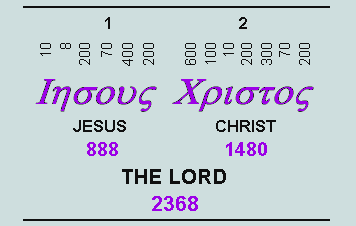
Observe that the Name, Title and Name+Title represent the numbers 888, 1480 and 2368, respectively. All are multiples of 37, and of 296, the 7th word of Genesis 1:1. Thus, 888 = 24x37 = 3x296; 1480 = 40x37 = 5x296; and 2368 = 64x37 = 8x296. So already we see the Creator's Name firmly linked numerically with the Bible's opening assertion, "In the beginning God made the heaven and the earth." - and this by a unique number per se together with a multiple which, very appropriately for the Incarnate One, represents the final word "earth". But there are also some beautiful geometrical links - which we shall now examine.
We begin with an alternative representation of the opening verse comprising 73 elements - each of 37-as-hexagon, thus:
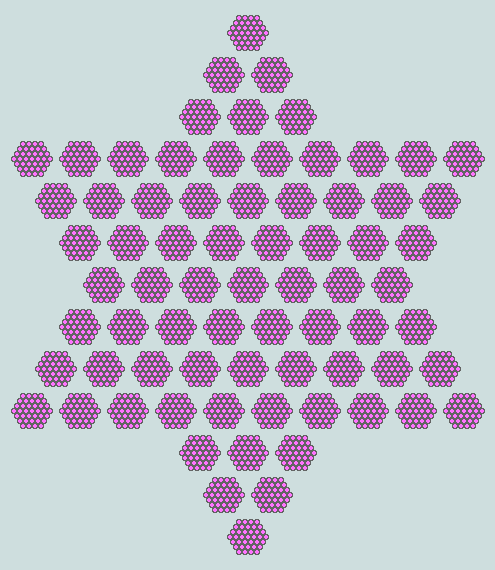
The sum of the final two words, both multiples of 37, may be represented, as before, as a central hexagon comprising 19 units of 37, thus:
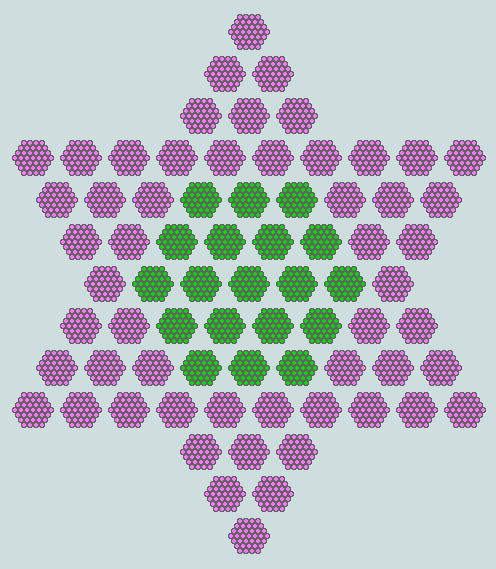
The impression created is that "...and the earth" is central to the whole creation enterprise.
Attention has already been drawn to the fact that within this hexagram of 73 units there exists another of 37 units; if the hexagon representing each unit is envisaged as a cube comprising 64 counters, then the Creator's Name (represented by 2368, or 64x37) appears at the centre of His creation, thus:
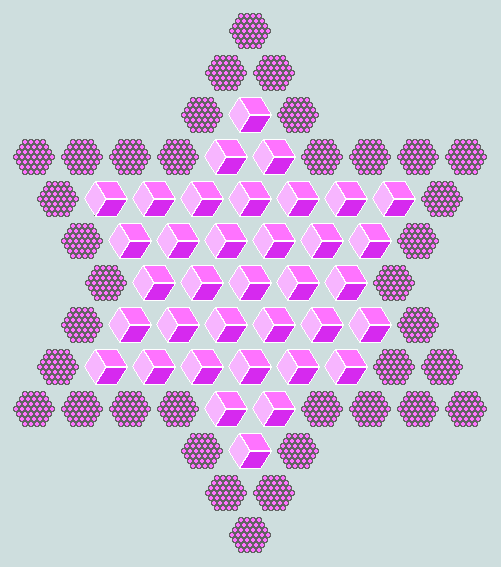
[This representation of the Lord at the centre of His creation becomes all the more significant when it is remembered that the cube is a biblical symbol of holiness (1Kings 6:20, Rev.21:16)]
The outline of this inner figure comprises 24 units, so that reverting to hexagons - each of 37 (and coloured blue) - we have a representation of 888, or "Jesus", thus:
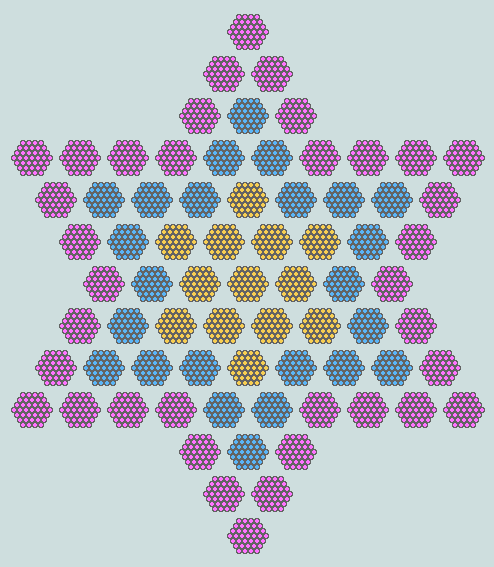
Interestingly, the innermost hexagram represents 13x37, or 481 - sum of 86 ("God") and 395 ("heaven").
Just two final points:
(1) The ratio 888:1480 (i.e. "Jesus":"Christ") is 3:5 - precisely that of the sides of the mercy seat, or propitiatory (Ex.25:17); this relationship is backed up by a number of NT references which speak of the Lord being the propitiation for our sins (e.g. Ro.3:25, 1Jn.2:2).
(2) The Greek rendering of "Word" is "Logos", thus:
The number represented by this string of letters is 373 - this revealing the factors of Genesis 1:1, viz 37 and 73.
25. A summary of the findings
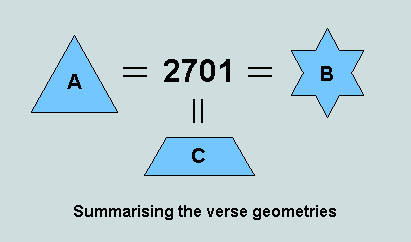
A = 73rd triangular number, having a cubic outline of 6x6x6 counters
B = compound figurate comprising 73 units of 37 - 4th and 3rd hexagrams
- C = trapezium: top = 55 (10th triangle); base, height = 91, 37 (trifigurates)
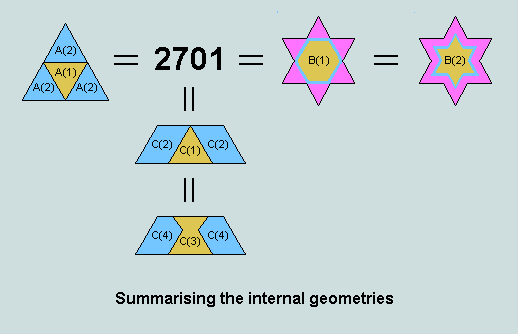
A(1) = 703 - 37th triangular number; sum of words 6 and 7
- A(2) = 666 - 36th triangular number; unique - all its attributes triangular
- B(1) = 703 - comprising 19 units of 37 - 3rd hexagon and 3rd hexagram
- B(2) = 481 - comprising 13 units of 37 - 2nd hexagram and 3rd hexagram
- representing the sum of words 3 and 5
- C(1) = 703 - 37th triangular number; sum of words 6 and 7
C(2) = 999; sum of words 1 and 3, and of words 2, 4 and 5
- C(3) = 913, i.e. word 1
- C(4) = 894; sum of words 2, 5 and 7, and of words 3, 4 and 6
25. Concerning the uniqueness of 2701 as a number, per se
The 7 Hebrew words of Genesis 1:1 comprise a total of 28 letters - 28, incidentally, being 7th triangular number and 2nd perfect number. Since the values represented by the first and last letters of the Hebrew alphabet are 1 and 400, respectively, the verse total must lie between 28 and 11200 - values approaching these limits deriving from 'nonsense' sentences. It is therefore instructive to consider in more detail those two features of the 2701 triangle that distinguish it from the crowd, viz (a) its cubic outline, and (b) its being the product of hexagon by related hexagram.
Regarding (a), we observe that the first 4 triangles possessing this feature are 55 (the 10th), 2701 (the 73rd), 29890 (the 244th) and 166753 (the 577th). Clearly, it is a rare attribute and - with the foregoing remarks in mind - 2701 is the sole candidate.
Regarding (b), 2701 is 3rd term in the sequence 91, 703, 2701, 7381, 16471,... It therefore competes with 91, 703 and 7381 in registering a presence in Genesis 1:1. However, it is the only one possessing a cubic perimeter. But observe that both 91 and 703 feature in this verse anyway.
Finally, it is worth noting that 2701 is the only 4-digit number whose factors are revealed when it is added to its digit reflection, thus 2701 + 1072 = 3773 (significantly, 37 and 73 also representing digit reflections). Clearly, these particular features are radix-dependent and speak strongly for 10 being the intended collective unit for use in our systems of numeration and mensuration.
It is interesting to know that such a number as 2701 - confluence of so many features of numero-geometrical interest - exists at all, and it is doubtful whether there can another like it in the whole range of the natural numbers. But what is equally remarkable is the fact that the first verse of the Hebrew Bible has discovered it! Taking into account all the things that might have been said in the first verse of 28 letters, the starting odds can therefore be modestly assumed to be of the order of 3000 to 1 against.
But, of course, the story does not end there; account has now be taken of the further independent wonders played out within the verse. So what are the further odds against a set of 7 numbers, (a) producing - as a single value, or sum of adjacent values - the only triangle capable of dividing 2701-as-triangle into, (i) a trio of 666-as-triangle or, alternatively, (ii) two equal parts, and (b) producing a further division into two equal parts when the first is set aside? And all these features represented by simple geometries placed symmetrically within the triangular or trapezial outer structure? Clearly, these are hard to quantify. But the general impression created must be that the accumulated 'odds against' are immense, and speak eloquently of a miracle of design. Since the Hebrew scheme of alphabetic numeration post-dates the writing of Genesis 1:1 by many hundreds of years, it is clear that here we have been contemplating a miracle of supernatural design.